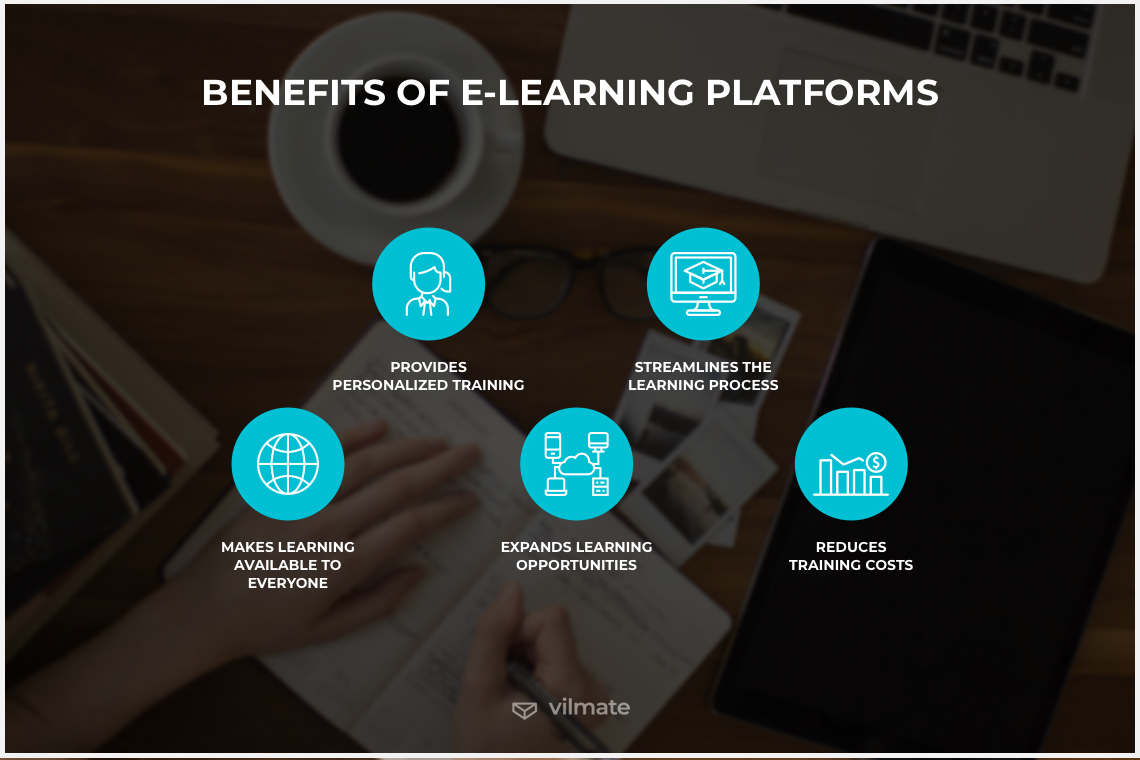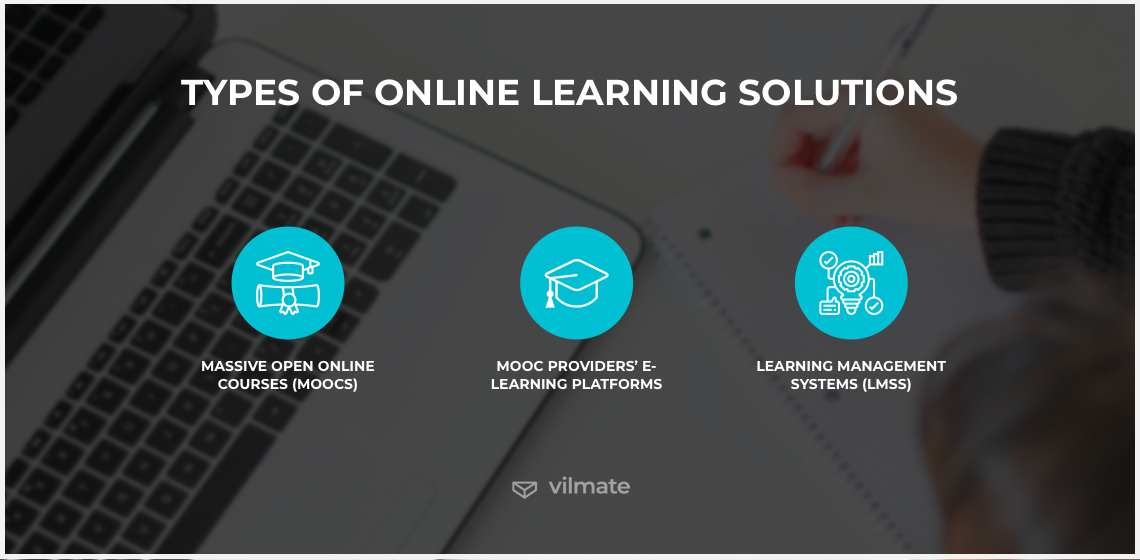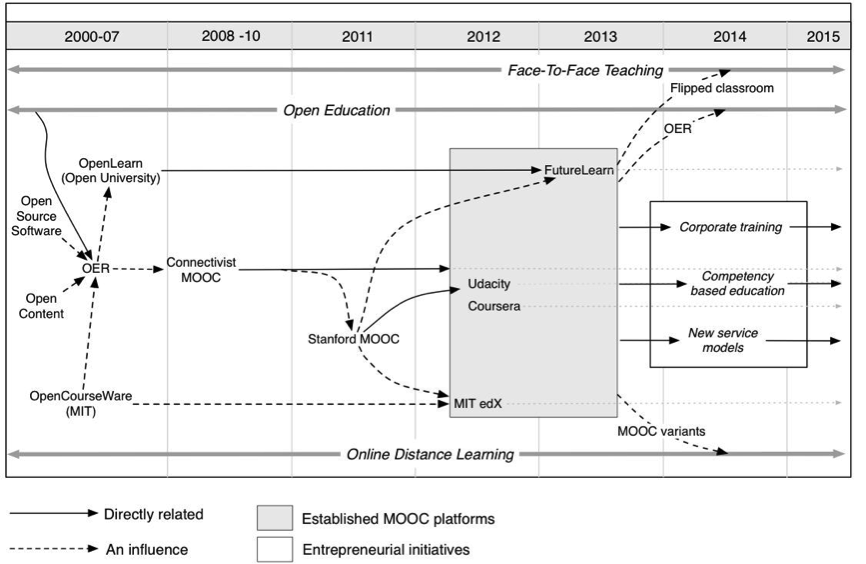Technology is a game-changer in education. It enabled teaching and learning to expand beyond classrooms and opened new doors of opportunities for kids and adults alike. Education is no longer just an academic pursuit. Obtained on e-learning platforms, it, in the first place, gives the tools to build a classroom-like learning environment where people can interact and learn from each other. It allows grasping the depths of the collective knowledge and gives the freedom to decide for oneself what skill or knowledge gaps to fill.
A new education-delivery system, online learning, has emerged as a viable, original method for accommodating various education needs. We are on the verge of a revolution in digital education, and the industry is longing for the technology that can be effectively integrated with the educational process.
This article explores the current state of e-learning, its potential benefits, and how to get started with one of the most in-demand online business models.
The present and future of e-learning platforms
E-learning is the term used to describe all online educational practices. The statistics show the market size of the e-learning market worldwide is forecast to surpass 243 billion U.S. dollars by 2022. A couple of years ago, market research firm Global Industry Analysts projected that the global eLearning market would be worth an impressive $107 billion in 2015, and so it happened. Digital learning technologies and practices are gaining traction among learners, businesses, education organizations, and governments. They are also becoming increasingly sophisticated, which has led to a phenomenal rise in the number of students attending online courses for academic credit.

More accessible now than ever before, eLearning offers a real change to the way the world sees education, as well as a real chance to get into new business and career fields. It can help us rethink our learning habits and provide a new way of seeing learning for a new generation. With online education, people can derive multiple benefits, including the following:
-
Makes learning available to everyone. Digital training helps educators and learners overcome barriers to learning by offering different kinds of educational settings that encourage the exchange of digital learning content.
-
Provides personalized training. Unlike traditional learning models, e-learning allows students to pursue their interests within a highly flexible framework. They are free to move at their own pace, receiving personalized support from their e-learning instructors.
-
Expands learning opportunities. Even when dedicated to a single online learning platform, a student can access both full-time and part-time courses, obtain professional certificates, complete Bachelor’s and Master’s degrees, choose the language that best suits them, and select specific universities or colleges.
-
Streamlines the learning process. E-learning platforms have appropriate monitoring and analytical tools in place. These tools help students track their progress and get feedback on how well they are doing, as well as understand what to focus on.
-
Reduces training costs. Online learning slashes the costs of training and fees associated with content delivery. Today, students can purchase a course, download the materials, and begin learning at a price that is sometimes lower than the cost of a single textbook.
Types of online learning solutions
Depending on the type of student-teacher engagement, the way of content delivery, and other factors, online learning solutions can be divided into massive open online courses, MOOC providers’ e-learning platforms, and learning management systems. Let’s see how to tell the difference between them.

-
Massive open online courses (MOOCs)
The open educational resources movement was sparked by the MIT OpenCourseWare project. Since then and up to 2012, each MOOC tended to develop its own delivery platform. Providing access to world-class education to anyone with an internet connection, they were a break-through in democratizing access to higher education.
At that time, there were two different types of massive open online courses: cMOOCs and xMOOCs. The former were known to be more dynamic and creative. They emphasized collaborative learning and knowledge building. The latter supported a more traditional approach. Their aim was to help learners obtain knowledge certification in a subject area of their choice. As time passed, it got clear that the industry was ready for a transition to the big MOOC providers’ age.
-
MOOC providers’ e-learning platforms
2012 was the year when Coursera, Udacity, edX, and other global MOOC providers began to emerge. Many of today’s MOOCs offer thousands of courses designed by top universities and authored by industry experts around the globe. Students can find a platform, pick a course, and begin learning in a matter of minutes. Before that, they have to pay a subscription fee, pay for a specific course, apply for financial aid, or even enroll totally free of charge.
Platforms also differ in how wide the range of subject areas they offer to study is: it can be wide and comprehensive as in the case with Coursera or narrow and specific as with Pluralsight. The source of MOOC providers’ content varies, too. One can either opt for obtaining a degree from high-profile universities as an alternative to offline education or go for courses designed by independent instructors and experts in their fields.
-
Learning management systems (LMSs)
An LMS is a cloud-based digital learning platform that is used for distance education. Moodle, Blackboard, and Canvas are the most popular learning management systems nowadays. LMS software allows users to create, track, manage, and distribute learning materials. It helps teachers manage curriculum, assignments, course syllabi, training materials, evaluation tools, and grades.
Using LMSs, educators and various organizations can develop, manage, and deliver coursework online. LMSs’ scope is not limited to educational institutions. Corporate LMSs, which are often part of the HR tech stack, are also widely used in the realm of business. However, they have not much to do with the initial purpose of learning management systems, which is online learning delivery and management, teacher- and instructor-facilitated learning, and training efficiency improvement.

Features to consider when building your e-learning solution
No matter if you’ve opted for a MOOC or a learning management system, there are some must-have administrative and interactive features your eLearning solution won’t be able to do without. Understanding these features from the user perspective and knowing how to leverage them to create the best educational experience possible can help you maintain the highest engagement of your users possible.
Administrative features of an eLearning platform
-
User authentication - Platform users have to be offered a variety of authentication methods to be able to login in the most convenient way. The student or teacher authentication process may involve the use of the email address, phone number, social network accounts, personal ID, etc. Secure authentication is required for access to the system.
-
Student profile - After signing up on your e-learning platform, a user should be able to quickly access their Student Profile. You can consider creating an onboarding process. Then, new users will be guided around the platform and prompted to fill out their personal profile before they can use the platform. Student Profile can also be accessed to see the agenda of the course a user has applied for, access the course materials, and get up-to-date information.
-
Search - Students must be provided with a handy way to discover new courses they may be interested in. E-learning platforms are basically catalogs of courses. To navigate through these catalogs, add categories and subcategories; offer courses recommendations based on user data, user activity, the latest and most popular courses, etc.; enable search by keywords; and do not forget about search filters like language, price, course provider, category, subject, and others.
-
Notifications and reports - Notifications are a powerful tool for informing users about new courses, upcoming deadlines for assignments, recommendations, special events, and more. Having alerts makes it easy to see what is happening in your classroom every day. Notifications may arrive in the form of push or in-app notifications and emails. If notifications inform about the current and upcoming events, reports are great for keeping track of student progress. A sound reporting system can be beneficial for both students and teachers, as it lets them know how efficient the course is and how successful students are on their assignments.
-
Student and course management - It must be convenient to track students’ progress within a course, manage contents availability and meetings for a class, and generate reports or graphs for members of the group. All in all, things cannot be left unattended, so a practical and efficient approach to organizing student work is essential. For proper course management, each course on a platform must have a corresponding course page. This page should include all syllabus materials, course description, instructor’s profile, and other information needed to manage student schedules and fulfill class requirements.
-
Certification - Finally, each student must be awarded a certificate on the successful completion of the course. The prerequisites to obtaining a completion certificate or any other type of certification are listed in the course syllabus and have to be complied with by the students. Automatic certification upon successful course completion is standard practice for many eLearning platforms.
Interactive features for an e-learning portal
-
Collaborative dashboard or whiteboard - Although communication and collaborative features are more often emphasized in learning management systems, they can also benefit regular e-learning platforms a lot. A collaborative dashboard can be used to plan e-learning activities and to help the system keep track of sessions and resources. In turn, the whiteboard provides a space for any problems that arise during an online lesson. The whiteboard can be used to help e-learning participants see their progress over time, and to share knowledge and ideas. It’s designed to be simple to set up and is customizable to share documents with different people.
-
Group chats - Group chats supporting voice and video are integrated with many non-educational platforms. Voice and video chat feature, however, is critical for establishing rapport with other students, as well as receiving guidance and training from teachers and instructors. Being able to interact with one another in a multimedia environment is critical for successfully educating today’s students. They will be able to discuss the concepts they are learning and how they can apply them to the real world, and ultimately be more engaged in the learning process. This interaction will provide a great opportunity to socialize, build relationships, and learn from the expertise of others.
-
File and screen sharing - Not only sharing of knowledge, information, and expertise is expected to be in store for students, those who use the portal should also be able to share media files. First, the availability of learning material aids in maintaining a safe and stable learning environment. Second, this feature will allow students to send teachers their complete assignments for review and grading. The screen sharing feature, in its turn, can be used by teachers to help students understand the subject. It must be an integral part of a virtual classroom where students can interact and solve problems together with teachers.
-
Broadcasting of lectures or classes - Not all the lectures within a course must be 100% interactive. Sometimes, it is better for a lecturer to rule the roost and be the one who talks, while the students are given the possibility to ask questions either as they come to their mind in a live chat or after the lecture is over. During lecture broadcasts, teachers can deliver presentations on the topic, which can result in improved student involvement, a better understanding of the subject, and higher student retention rates.
-
Multi-device usage - Today’s learners are used to consuming content on the go. Therefore, people should be able to continue their learning while using multiple devices without risking to miss any information. A multi-device access to the content through e-learning modules in a cloud environment is one possible solution. Learners expect that they could access always up-to-date digital content at any time and place from their smartphones, laptops, tablets, or PCs.
-
Reviews and ratings - Reviews and ratings are an ultimate marketing tool for an online learning website and online courses. The more students share their positive experience with the platform or a specific course, the more the website becomes associated with quality. Besides, via the review section, newcomers can find out how relevant and useful the course is before enrolling. To receive feedback from as many students as possible, ensure that it takes no extra effort on their part to rate the course and write a review. Make it clear and easy for students to rate your course as they finish.
Examples of the most popular online learning platforms
Let’s now look at the examples of digital education platforms that have managed to create vibrant communities of learners and thus spread knowledge among people around the world. So many educational platforms are built by enthusiasts and believers in how learning should be done; we cover a few examples below.
| eLearning platform name | Number of students | Number of courses | Pricing options | Certificates | Categories | Course content providers |
| Udemy | 50 million+ | 150,000+ |
|
A certificate of completion | Any | Individual instructors |
| Coursera | 47 million+ | 3,000+ |
|
Professional certificates and degrees | Any |
|
| Udacity | 8 million+ | 200+ |
|
University credit courses and nanodegrees | Business and IT | Higher education institutions |
| edX | 20 million+ | 2,200+ |
|
University-level degrees, course and program certificates | Any | Higher education institutions and private entities |
| Pluralsight | 1 million+ | 6,000+ |
|
Certificates of completion | IT | Individual instructors |
| Lynda by LinkedIn | 17 million+ | 3,500+ |
|
Certificates of completion | Business, Creativity, and IT | Individual instructors |
The cost to develop an e-learning application
How much eLearning platform development will cost and how long it will take to create a functioning product depends on a number of factors. First, one has to decide on the level of the future online learning platform complexity. Then, when the framework is outlined, it will be easier to proceed with defining development time and cost. The rough estimates are given in the table below.
| Level of sophistication | Characteristics | Total cost |
| Basic development |
|
$10,000-15,000 |
| A medium-complexity website |
|
$20,000-50,000 |
| Complex web development |
|
$70,000+ |
For the cooperation between the client and the software development team to be productive, both parties have to understand the end goal from the outset.
-
How many active users are there going to be on your eLearning platform?
-
Will or will you not work directly with industry experts and qualified educators to create content for a platform?
-
Are you setting realistic deadlines in the project?
-
Are you considering the costs of ongoing maintenance, improvements, and revisions?
These and other questions must be answered before drawing up the budget for your e-learning web development project.
Conclusion
The eLearning market is already saturated with educational platforms. But the revolution in an online learning sector is still ongoing. Getting degrees, certificates, and diplomas online is becoming increasingly viable. Educational institutions and groups of enthusiasts share knowledge, wisdom, and hard-earned experience with the world.
Accordingly, technologies are developing, too, allowing for the use of more sophisticated eLearning tools. So, it’s executable now to come up with the right platform that offers the right features to learners for them to achieve their best results. Having a vision, leveraging the experience of others, and building up the right team, you can create an excellent e-learning website, too.

© 2020, Vilmate LLC




